
Winged Restoration Project to expand monarch habitat
by Suzanne Gill
Communications and Outreach Coordinator
While the monarch butterfly is among the most beloved wildlife species in the U.S., populations of both the Eastern and Western monarch have declined precipitously since the late 1990s. By 2019, the Western monarch population was estimated to have plummeted to just two percent of the total recorded 22 years earlier, in 1997. The loss of migratory habitat was considered a primary reason for the population collapse, but pesticide use and global climate change were deemed significant contributors as well, according to sources including the Swiss-based International Union for Conservation of Nature and Natural Resources*.
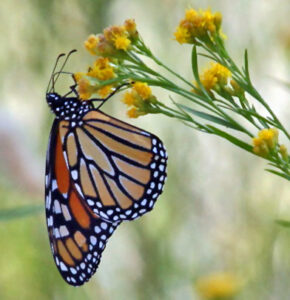
Monarchs require the milkweed plant for survival. While they will seek a number of nectar plants for food, monarchs lay eggs only on milkweed. Later, the developing young consume a toxin from the plant that helps ward off predators. Before these needs were fully understood, milkweed was usually treated as a nuisance plant and removed in the process of land development.
After declining to numbers that suggested extinction was imminent, the Western monarch population rebounded in 2021, when thousands were observed in Pacific Grove and other Central California locations. Even more were counted in late 2022, but totals remained at just a fraction of historic numbers.
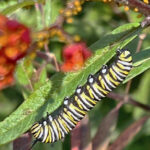
In an effort to restore and enhance habitat for the Western monarch butterfly and other declining pollinators, the State of California’s Wildlife Conservation Board allocated funds this year for an ambitious habitat restoration effort that involves a handful of sites on privately-owned conserved land across Monterey and San Luis Obispo Counties. Winged Restoration on California’s Central Coast is a multi-year project with a $303,600 budget and very high hopes for the return of thriving monarch populations.
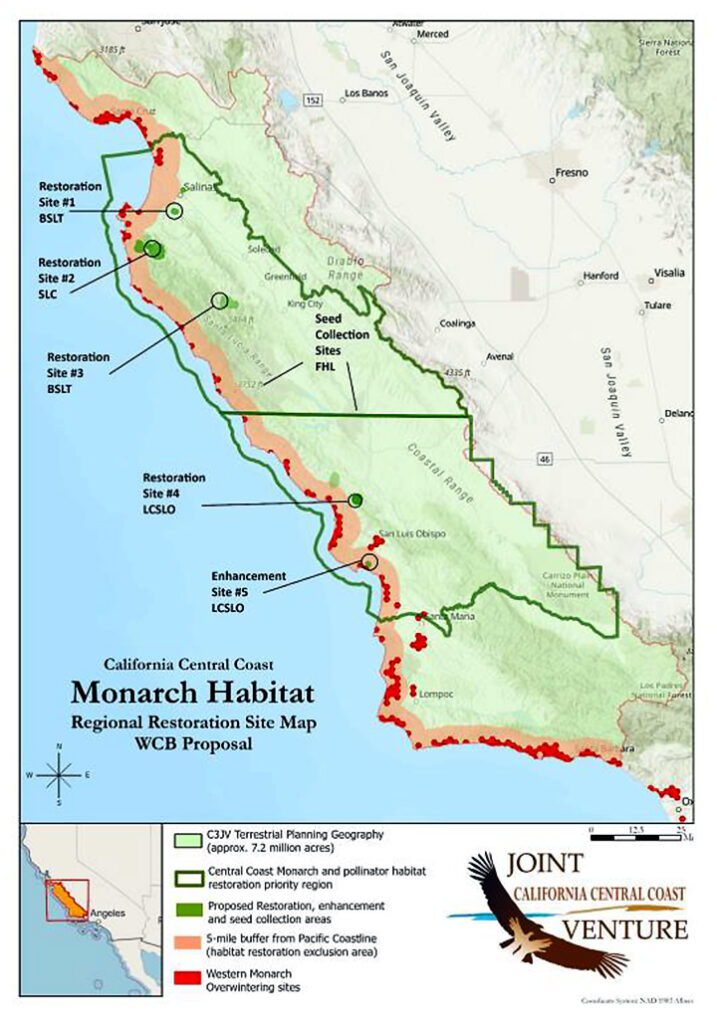
Peñon Peak at the Santa Lucia Preserve is among five key habitat restoration sites comprising the Winged Restoration project. [See map.] Two more sites in Monterey County and two in San Luis Obispo County will also participate. If the Western monarch population is to recover, these locations along the butterfly’s migratory stopover routes are considered critical.
To prepare the site for planting, water infrastructure at Peñon Peak will be provided by a 5,000-gallon tank, to be installed by the end of 2023. The tank will guarantee moisture for milkweed seedlings and supply water to three pastures at some of The Preserve’s highest elevations, expanding the grazing area for the Conservancy’s herd.
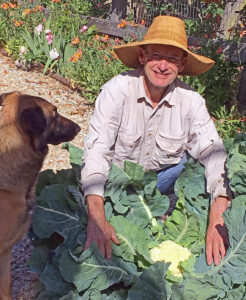
Santa Lucia Conservancy board members Jim Andrasick and Scott Hennessy are directly involved in the seedling project. Jim, whose home is on Long Ridge Trail, has been growing milkweed for several years. Now, Jim’s field has provided Scott with roughly 5,000 seeds, which he is beginning to propagate along with other local seed stock. Their combined effort should supply thousands of seedlings for the project.
Two planting and seeding efforts will be carried out at Peñon Peak in 2024. In late fall, 10,000 milkweed seedlings – including Scott’s – will be planted to establish a monarch breeding ground. In addition, a native wildflower seed mix will be planted to provide nectar-rich flowers for mature monarchs – and other pollinators, including bees and butterflies – to feed on. Critically, these are spots that have been grazed by the Conservancy’s herd, clearing the ground of thatch so that seed will contact soil and germinate.
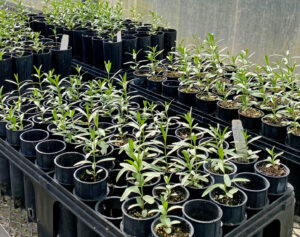
As the Winged Restoration Project proceeds in 2025 and beyond, data will be collected to help assess the success of the project and answer questions including: Which methodologies effectively supported both migratory stopovers and feeding for the monarchs? And, what were the outcomes of the seeding and planting efforts at the selected sites? This research will give biologists a better understanding of the monarch’s complex life cycle, migratory habits, and habitat requirements going forward.
*https://www.iucn.org/press-release/202207/migratory-monarch-butterfly-now-endangered-iucn-red-list
Top photo captured on wildlife camera at Long Ridge Trail in 2015. Other photos for the story were contributed by Scott Hennessy.